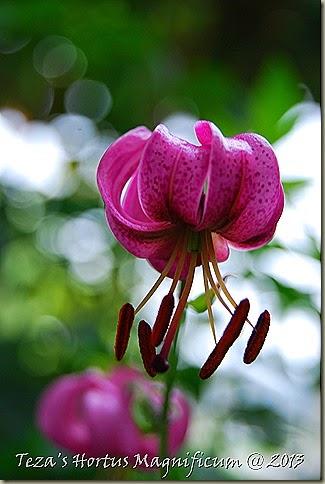Have you ever stumbled across a plant – something you’ve never seen before, but something nonetheless that by all rights should reside in your garden? Its one of those late night computer games I like to play when the mind is telling me I should head to bed, but the fever for new and exciting plants simply will not extinguish itself – if only for six or seven hours!
Take for example the smashing plant in the header photo for this post: Scoliopus bigelovii!
Scoliopus is a genus in the Liliaceae family with two species that are native to cool moist woodland in Oregon and California. They are one of the fringe geophytes with underground stems with numerous fleshy storage roots. They are known by common names of slink pod because of the long seed pod that "slinks" and buries the seed in the ground and fetid adders-tongue because they have a fetid scent although it is not very strong and you have to get very close to smell it. They bloom late winter to early spring, one of the early wildflowers in their native habitat. Scoliopus bigelovii is a northern coastal California species that is found in very wet habitats: mossy streambanks and moist, shady forests. [Pacific Bulb Society]
Scoliopus bigelovii comes from moist woodland areas in Oregon and California, flowering in late winter and early spring. It is proving to be hardy in British gardens when grown in cool acid woodland or peat-bed conditions, appreciating partial shade where it may gently seed itself about. When grown in the open garden, protection from slugs is advised as the seed pods push themselves downwards towards the soil prior to releasing the seed, making them virtual gastropodic picnic baskets. This seed dispersal method resembles that of Trillium rivale and although the floral parts of Scoliopus superficially resemble those of a Trillium, both are thought to be coincidental; they are not botanically related, Scoliopus being closer to the genera Calochortus and Tricyrtis in the Liliaceae.
The colour of the beautifully marked flowers, with their broad recurved petals, can vary not only in the shade of yellow in the background but also in the amount of brown streaking and spotting. Unerringly constant however, is the reminder of its colloquial name 'Fetid adders-tongue'....... it stinks! Just a few open flowers in my greenhouse was enough to announce their arrival. The odour is best described as that of a wet dog (that has also rolled in something nasty), necessary to attract carrion beetles, its putative pollinators.
Despite this failing, it does make an excellent pot plant for the alpine house giving a much needed lift to the cold dark days at the start of the year. [Alpine Garden Society]
I think I’m in love! Falling somewhere on the scale between Trillium and Tricyrtis, how could I not? Now if I only knew the directions to my ‘Alpine House.’ I know it is around here somewhere.

































3 comments:
Isn't that an exotic one ! Almost magical in its home. Bestest finding your Alpine House, I haven't found mine yet either :)
Now isn't this a gorgeous plant!
I haven't seen this one before either .. hey, stop playing games and go to bed !! LOL
Joy
"Have you ever stumbled across a plant – something you’ve never seen before, but something nonetheless that by all rights should reside in your garden?"...oh yes! And those are the very best days.
Post a Comment